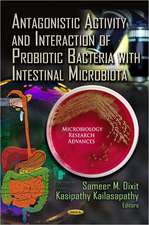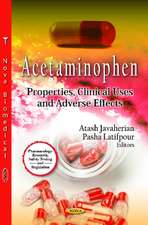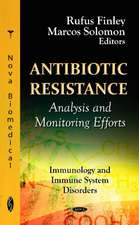Drugs and Poisons in Humans: A Handbook of Practical Analysis
Editat de Osamu Suzuki, Kanako Watanabeen Limba Engleză Paperback – 12 oct 2010
Includes source of chemicals needed for the experiments
Texts are composed by 67 experts in analyzing the respective compounds
Clear and uniform structure of chapters for ease of reading
The text is illustrated by many diagrams and tables
| Toate formatele și edițiile | Preț | Express |
|---|---|---|
| Paperback (1) | 2125.43 lei 6-8 săpt. | |
| Springer Berlin, Heidelberg – 12 oct 2010 | 2125.43 lei 6-8 săpt. | |
| Hardback (1) | 2131.65 lei 6-8 săpt. | |
| Springer Berlin, Heidelberg – mai 2005 | 2131.65 lei 6-8 săpt. |
Preț: 2125.43 lei
Preț vechi: 2237.30 lei
-5% Nou
Puncte Express: 3188
Preț estimativ în valută:
406.74€ • 422.07$ • 339.97£
406.74€ • 422.07$ • 339.97£
Carte tipărită la comandă
Livrare economică 17-31 martie
Preluare comenzi: 021 569.72.76
Specificații
ISBN-13: 9783642060878
ISBN-10: 3642060870
Pagini: 694
Ilustrații: XVIII, 672 p. 236 illus.
Dimensiuni: 155 x 235 x 38 mm
Greutate: 0.96 kg
Ediția:Softcover reprint of hardcover 1st ed. 2005
Editura: Springer Berlin, Heidelberg
Colecția Springer
Locul publicării:Berlin, Heidelberg, Germany
ISBN-10: 3642060870
Pagini: 694
Ilustrații: XVIII, 672 p. 236 illus.
Dimensiuni: 155 x 235 x 38 mm
Greutate: 0.96 kg
Ediția:Softcover reprint of hardcover 1st ed. 2005
Editura: Springer Berlin, Heidelberg
Colecția Springer
Locul publicării:Berlin, Heidelberg, Germany
Public țintă
Professional/practitionerDescriere
It was with great pleasure that I accepted the invitation to write the foreword for Drugs and Poisons in Humans. A Handbook of Practical Analysis. Dr. Osamu Suzuki and Dr. Mikio Yashiki, two outstanding Japanese scientists, f rst published the Handbook in Japanese in 2002. Specialists throughout Japan contributed analytical methods for a wide variety of therapeutic and illicit drugs, pesticides, and natural toxins and alkaloids. In fact, rarely has such a wide spectrum of analytes and metabolites been addressed within a single reference manual. At the beginning of the book, general topics are addressed, including instructions on h- dling biological materials, measurement of drugs in alternative specimens, and guidance on resolving analytical problems that may occur. T ere are discussions of extraction modalities and detection methodologies and how to select these appropriately based on the physioche- cal characteristics of the drug. Analysis of specif c classes of drugs and relevant metabolites are covered in subsequent chapters. Clinical, analytical and forensic toxicology and clinical ch- istry laboratories will f nd the volume informative and useful. Toxicologists are of en faced with developing methods for new drugs and metabolites with little information available in the literature. T is book provides a great starting point for method development providing pro- dures that have been utilized in real life situations. In addition, toxicologists developing new methodologies may use this volume as a guide to selecting the most appropriate instrumen- tion to handle the breadth of their analytical workload.
Cuprins
Chapters of general nature 1) How to handle biological specimens2) Alternative specimens3) Pitfalls and cautions in analysis of drugs and poisons 4) Pretreatments of human specimens5) Detection methods6) A computer system for diagnosis of causative drugs and poisons developed by the Japan Poison Information Center (Tokyo)7) Practical use of the poison-net developed by the Japan Poison Information Network (Hiroshima)8) Problems in toxin analysis in emergency medicine9) Analyses of chemical weapons and their related compounds Chapters on specific toxins 1. Volatile compounds 1) Carbon monoxide2) Hydrogen sulfide and its metabolites3) Cyanide4) Methanol and formic acid5) Ethanol6) Chloroform and dichloromethane7) Toluene, benzene, xylene and stylene8) Alkyl nitrites9) Compenents of gasoline and kerosene 2. Controlled drugs1) Amphetamines and their metabolites2) Cannabinoids and their metabolites3) Morphine and its analogues4) Cocaine and its metabolites5) Pentazocine6) Lysergic acid diethylamide (LSD)7) 3,4-Methylenedioxyamphetamines8) Phencyclidine9) ?- Hydroxybutyric acid 3. Psychopharmaceuticals and hypnotics1) Phenothiazines2) Butyrophenones3) Tricyclic and tetracyclic antidepressants4) Benzodiazepines5) Bromisovalum6) Barbiturates 4. General drugs1) Diphenylmethane antihistaminics2) Propionic acid derivative analgesic-antipyretics3) Acetaminophen (paracetamol)4) Acetylsalicylic acid5) Antiepileptics6) Muscle relaxants7) ß- Blockers8) Local anaesthetics9) Salicylicacid 10) ß- Lactam antibiotics 5. Chemicals of daily necessaries1) Hypochlorite2) Benzalkonium chlorides3) Hair dyes4) Permethrin5) Boric acid6) Naphthalene7) p-Dichlorobenzene8) Ethylene glycol 6. Natural toxins and alkaloids1) Aconite toxins2) Mushroom toxins3) Tetrodotoxin4) Methylxanthine derivatives5) Nicotine and cotinine6) Tropane alkaloids7) Oleander toxins 7. Pesticides1) Simultaneous analysis of pesticides by GC/MS2) Organophosphorus pesticides3) Glufosinate and glyphosate4) Carbamate pesticides5) Paraquat and diquat6) Cresol7) Diazine and triazine herbicides8) Coumarin rodenticides 8. Miscellaneous1) Sarin and its decomposition products2) VX and its decomposition products3) Sodium azide4) Arsenic compounds and other inorganic poisons5) Nitrate and nitrite compounds6) Methemoglobin
Caracteristici
Unique analysis of drugs and poisons to facilitate testing in all laboratories even by inexperienced chemists
Includes source of chemicals needed for the experiments
Texts are composed by 67 experts in analyzing the respective compounds
Clear and uniform structure of chapters for ease of reading
The text is illustrated by many diagrams and tables
Includes supplementary material: sn.pub/extras
Includes source of chemicals needed for the experiments
Texts are composed by 67 experts in analyzing the respective compounds
Clear and uniform structure of chapters for ease of reading
The text is illustrated by many diagrams and tables
Includes supplementary material: sn.pub/extras












